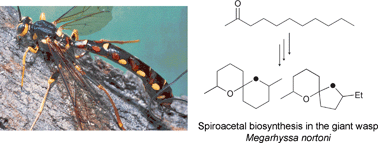Covering: up to the end of 2008
The volatile secretions of numerous species of Coleoptera (beetles), Hymenoptera (wasps, bees) and Diptera (true flies) contain complex blends of spiroacetals. In several species, a certain number of them appear to function as sex pheromones. The structure of insect-derived spiroacetals will be summarised and the techniques useful for their identification and the investigation of their biogenesis will be discussed. Progress in the study and delineation of likely biosynthetic pathways to these spiroacetals in Dipteran (Bactrocera) and Hymenopteran (Megarhyssa) species will be reviewed, and the validity of these pathways as a general paradigm for spiroacetal generation in the wider insect world will be assessed.
You have access to this article
 Please wait while we load your content...
Something went wrong. Try again?
Please wait while we load your content...
Something went wrong. Try again?


 Please wait while we load your content...
Please wait while we load your content...